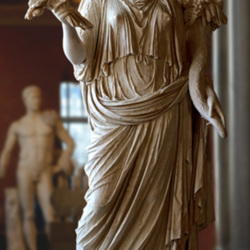Livia as Ceres
Title
Date
Artist or Workshop
Materials
Height of the work
Provenience
Current Location
Description and Significance
Description:
The portrait of “Livia as Ceres” depicts a standing female figure in contrapposto posture with the weight distributed on the left side of the body and the right knee softly bent. The right arm is bent at the elbow and extends forward; the hand clasps a small sheath of wheat. The left arm is held closer to the body, cradling an abundantly filled cornucopia. The figure wears a draped chiton, a rectangular Greek costume stitched on the sides and pinned along the arms and shoulders. She has a matronly body with prominent, full breasts and a waist emphasized by cording visible from the overfold of the chiton. A square mantle, a palla, drapes over the chiton and also serves as a partial veil to cover the figure’s hair. The palla wraps over the head of the figure and around the waist; it drapes over the left wrist before falling and hanging down the length of the body. On her head, the figure wears a floral wreath and an infula, a woolen headpiece knotted into bead-like shapes to be worn under the veil. The figure’s hair is styled with side waves and a nodus above the crown of her head, and small wisps of hair fall over the forehead from the coiffure. The face is unlined, fleshy, and idealized, yet features a narrow jawline and chin with a pouting mouth, small eyes, and a broad Julio-Claudian forehead that show similarities to portraits of Livia’s son, Tiberius, during his reign as emperor.
Significance:
The portrait of “Livia as Ceres” serves to display Livia’s importance in the worlds of Augustus and Tiberius, yet it varies greatly in the meaning of its imagery and functions. Scholars have noted that the portrait was heavily restored in the late 18th century—the arms, cornucopia, part of the floral crown, and pieces of veil around the neck were all later additions to the sculpture, calling into question its function during Julio-Claudian times. It has been suggested that before restoration, the attributes original to the sculpture could have indicated Livia’s imperial roles rather than priestly duties or the guise of a goddess. However, it would not be uncommon to depict her in the guise of Ceres—similar imagery also exists in examples of Livia’s portraiture found in Madrid and Tripoli. The goddess Ceres was known to Romans as symbolizing agriculture and motherhood, concepts featured in the attributes of a full cornucopia, floral crown, and sheath of wheat that suggest the fertile and nourishing nature of a mother figure. Some scholars have proposed that the portrait presents Livia as a priestess of Ceres because of the symbol of the cornucopia, but historic evidence does not account for her religious roles at this time outside of the designation as a priestess of the deified Augustus. The costume worn by the figure has also been challenged: it has been suggested that Livia is dressed in the chiton, a common costume found in many of her other full-bodied portraits, though it can also be construed as a stola, a pleated robe often worn by Roman matrons. If the costume is understood as the stola, it would function to define Livia in her role as the wife of the late emperor, Augustus, and as the mother of the new emperor, Tiberius. In the costume of the stola, particularly with the head covering of the palla, Livia embodies the dignity and modesty of matrons in Augustan ideology. In Ceres’ guise, Livia takes on the role of the nurturer with her success at providing not only a male heir to Augustus, but for the new hope for Rome’s future under the rule of Tiberius. At the time of Tiberius’ accession as emperor, the figures of Livia and Ceres were assimilated in art, possibly caused by Tiberius’ refusal to provide Livia with the designation of mater patriate, the mother of Rome. In representing Livia so vastly in the portrait of “Livia as Ceres,” it is possible that the sculpture was meant to help the viewer dwell on Livia’s imperial and priestly roles throughout her life, particularly as a mother to Tiberius and therefore to all of the empire —and her impact on the governing and growth of Rome far into the future.
References
Barrett, Anthony A. "Livian Themes." Livia: First Lady of Imperial Rome, Yale UP, 2002, p. 210. Print.
Bartman, Elizabeth. Portraits of Livia: Imaging the Imperial Woman in Augustan Rome. Cambridge, Cambridge UP, 1999, pp. 42; 45; 105-106; 115; 168. Print.
Giroire, Cécile, and Daniel Roger. "Portrait of Livia as Ceres." Roman Art from the Louvre, New York, American Federation of Arts in association with Rizzoli, 2007, p. 70. Print.
Sebesta, Judith L. "The Costume of the Roman Woman." The World of Roman Costume, edited by Judith L. Sebesta and Larissa Bonfante, Madison, Univ. of Wisconsin Press, 2001, pp. 48-50. Print.
Williams, Rose. "Roman Ceres." The Original Dysfunctional Family: Basic Mythology for the New Millennium, Mundelein, Bolchazy-Carducci Publishers, 2008, pp. 46-47. Print.
Contributor
Citation
Item Relations
This item has no relations.

